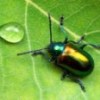
I've never understood the controversy over the Superorganism concept. It isn't as though organisms themselves are all that clear-cut, especially when considering oddities like social amoebas and lichens.
photo details: Canon 100mm f2.8 macro lens on a Canon EOS D60
ISO 400, 1/10 sec, f/2.8

I just started reading Holldobler and Wilson's book by that same name.
Another example would be the Portuguese man o' war.
I think the controversy is within the population genetics community. Which models are more accurate? Those which treat the ant colony as a discrete organism and test allele frequency, or the allele frequency of the colony population? Both, I believe, come up with different results to explain ecological phenomena.
Anon-
Thanks, I can see how trying to fit data into different pop gen models might force some disagreements.
But isn't the problem superficial? Alleles exist in quantifiable proportions both in colonies and in populations in such a way that should be treatable in a single mathematical framework. The rest is just semantics.